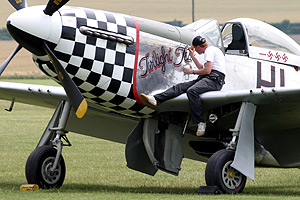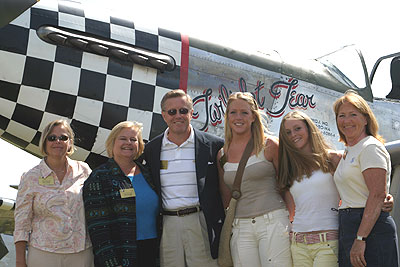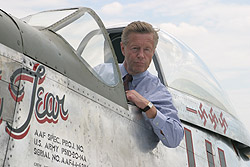Home | Airshows | The Hangar | Nostalgia | Links
 Living
Legend
Living
Legend
Pictures by Gary Parsons
Set to make its debut at this week's Flying Legends Airshow at Duxford is a genuine Duxford-based wartime Mustang, now back in her original wartime colours.
The aircraft, called 'Twilight Tear', was based at Duxford with the USAAF 78th Fighter Group towards the end of the Second World War. The personal aircraft of young American pilot Lt Hubert 'Bill' Davis, who flew the bulk of his 35 combat missions and achieved three aerial victories in her, Twilight Tear's survival is remarkable in that, at the end of hostilities, most of the Groups' aircraft were flown to a depot near Blackpool for scrap.
 |
|
Hubert
Davis had three children - son Bob and daughters Louisa and Virginia.
They are all at Duxford together with Bob's two daughters. Their
verdict? "A very emotional day"
|
The aircraft was acquired from Scandinavia by the Duxford-based Fighter Collection in April 2002 and it was whilst carrying out a thorough over-haul and maintenance work that the aircraft's true identify was discovered - incredibly, Twilight Tear had come home. Immediately, efforts began to trace her pilot and his family. Sadly Lt Davis died tragically young in 1967, aged just 48, but his son and two daughters in America were traced and were astonished to learn that their father's aircraft, which he had named after a famous American race horse, had been found. They are at Flying Legends to witness Twilight Tear, restored to her former glory, make her air show debut and to pay homage to their late father's wartime exploits.
 |
|
Bob
Davis, son of WWII fighter pilot Lt Hubert Davis, sits in his father's
actual aircraft some fifty-nine years later at the press launch
for Duxford's Flying Legends Airshow
|
Twilight Tear, in her distinctive Duxford chequer board markings, will be joined by approximately eight other P-51 Mustangs, together with ten Spitfires in a 'Spitfire Scramble', several Hurricanes (including TFC's new Mk IV KZ321), the display debut for OFMC's La-9, the Breitling Fighters, a German Junkers Ju-52, the world's only airworthy Bristol Blenheim and the mighty B-17 Flying Fortress, Sally B. Also scheduled to fly are the Fighter Collection's impressive stable of aircraft including the Bearcat, Tigercat and Hellcat and the gutsy P-47 Thunderbolt.
Lavochkin La-9 to make its debut
 Extract
from OFMC site (www.ofmc.co.uk)
Extract
from OFMC site (www.ofmc.co.uk)
A Russian built aircraft, it arrived too late to participate in the Second World War, the first La-9 being flight tested in November 1946, with series production beginning in 1947. An ASH-82FN air-cooled 14-cylinder engine of 1850 hp driving a three-blade propeller powered the aircraft.
1,630 La-9s were built and served with the Soviet Air Force, and in small numbers in Bulgaria and other East block countries. In 1950/51 large numbers were delivered to China and some to North Korea where they were involved in early fighting during the Korean War. On several occasions they were involved in combat with USAAF F-86 Sabre jets and other allied aircraft.
In design and performance the La-9 was the equivalent of the American Bearcat and the British Sea Fury, heavily armed with 4x 23mm cannon, mounted in the nose.
The Old Flying Machine Company's aircraft (serial Number 828) flew with the Soviet Air Force before being transferred to the Chinese Air Force in 1950. Taken out of service in the early 60s the aircraft became a technical exhibit at the Beijing University of Aeronautics and Astronautics, where in 1986 negotiations were begun to obtain the aircraft for restoration in the United Kingdom. Following ten years of complex discussion, agreement was finally reached and the aircraft was delivered to Duxford in 1996.
 After
initial inspection and appraisal the decision was made to ship the aircraft
to New Zealand (2001) to be re-built to flying condition by Pioneer Aero
Restorations at Auckland’s Ardmore Airfield. The engine and propeller
were overhauled in the Czech Republic in 2002 and the combination mated
to the airframe in New Zealand in January, 2003. The
completed aircraft finally returned to Duxford during May.
After
initial inspection and appraisal the decision was made to ship the aircraft
to New Zealand (2001) to be re-built to flying condition by Pioneer Aero
Restorations at Auckland’s Ardmore Airfield. The engine and propeller
were overhauled in the Czech Republic in 2002 and the combination mated
to the airframe in New Zealand in January, 2003. The
completed aircraft finally returned to Duxford during May.
Home | Airshows | The Hangar | Nostalgia | Links

